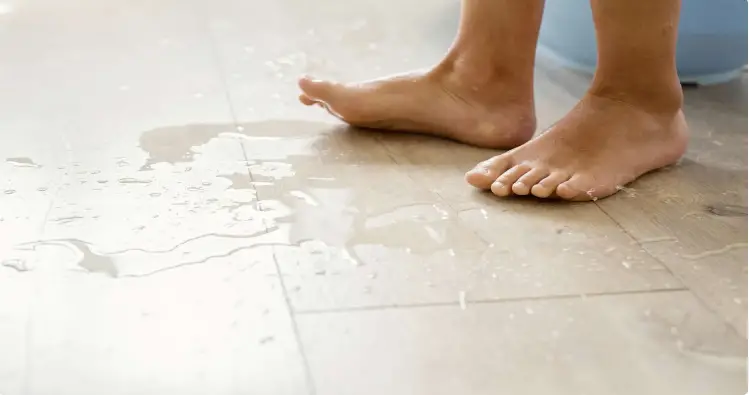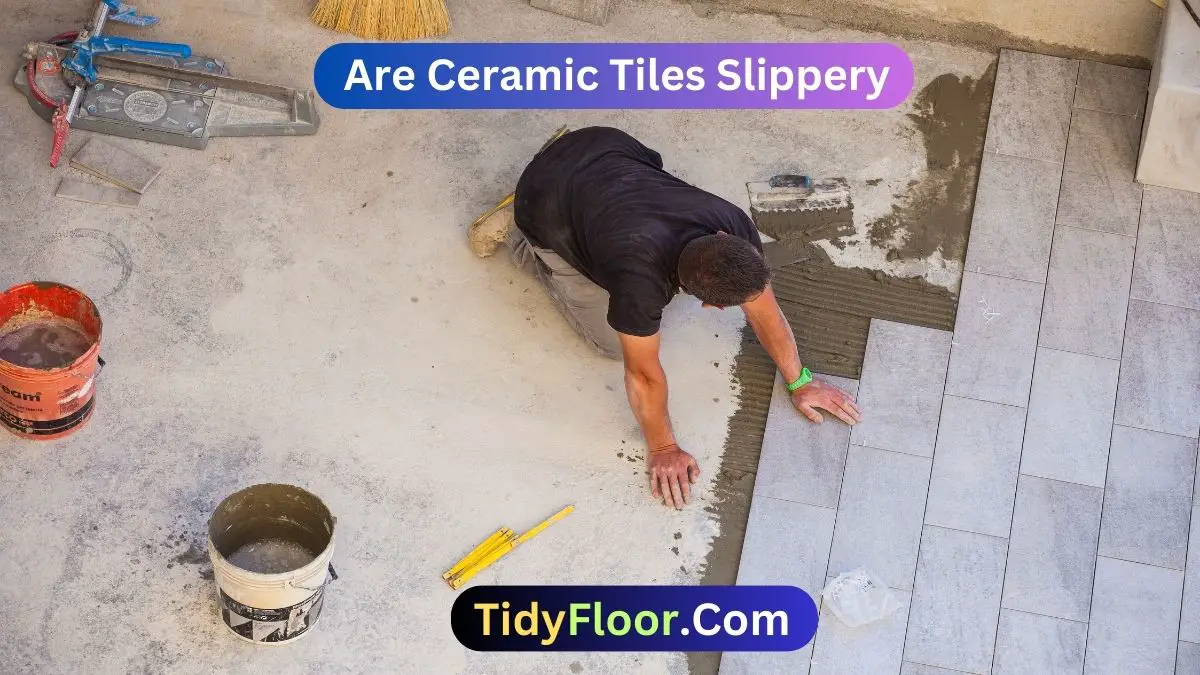Ceramic tiles have long been a popular choice for flooring due to their versatility and aesthetic appeal. However, a common concern among homeowners is the potential slipperiness of these tiles. But are ceramic tiles slippery or is it just a guess?
Ceramic tiles can be slippery, especially when wet. The smooth, glazed surface of ceramic tiles can become slippery, posing a slip hazard, particularly in areas prone to moisture like bathrooms and kitchens. To mitigate this risk, it’s essential to use slip-resistant coatings or mats.
In this article, you explore the slipperiness of ceramic tiles, addressing concerns and providing practical tips for a safe and slip-resistant flooring experience.
Factors That Affect Ceramic Tile Slipperiness:

Let’s talk about why some ceramic tiles can be slippery. It’s like figuring out why some floors are more slidey than others. We’ll look at things like how smooth they are and if they get wet – all to make floors safer.
#1- Surface Texture:
Surface texture is the feel or smoothness of a material. In flooring, it affects slip resistance. Smooth surfaces can be slippery, while textured ones offer better grip, enhancing safety.
#2- Moisture Levels:
Moisture levels refer to the amount of water present. In flooring, high moisture can make surfaces slippery, posing a risk. It’s crucial to address and manage moisture to enhance safety.
#3- Type Of Glaze:
The slip resistance of tiles is affected by the glazing process in manufacturing. Certain tiles receive treatments to improve grip, while others retain a smooth surface. Understanding these variations helps in choosing tiles that align with desired safety levels.
#4- Coefficient Of Friction (COF):
The Coefficient of Friction (COF) measures how slippery or resistant a surface is. In flooring, it’s crucial to assess slip resistance. A higher COF indicates better traction, aiding in choosing safer and more secure flooring materials for various environments. Understanding COF contributes to creating safer living and working spaces.
#5- Tile Size And Shape:
Tile size and shape play a role in flooring safety. Larger tiles can provide a more contact surface, potentially reducing slipperiness. The design and pattern influence water dispersion, affecting overall slip resistance. Considering these factors helps in choosing tiles that contribute to a safer environment.
#6- Underlying Surface:
The underlying surface is the foundation beneath the flooring. It significantly influences tile stability. A well-prepared and even subfloor contributes to better adherence, enhancing the overall safety and longevity of the flooring installation. Understanding and addressing the underlying surface is crucial for a secure and durable flooring experience.
#7- Grout Lines:
The tiles themselves may not be inherently slippery. However, grout lines between tiles can collect moisture and dirt, creating a slippery surface, particularly if not properly maintained.
10 Best Ways To Reduce Ceramic Tiles Slippery:
Reducing the slipperiness of ceramic tiles is crucial for safety, especially in areas prone to moisture. Here’s a comprehensive guide on the best ways to achieve slip resistance:
Way 1: Choose Textured Tiles
Opting for ceramic tiles with textured surfaces or matte finishes is a proactive approach to reducing slipperiness. Textured tiles provide better traction underfoot due to their rougher surface, offering improved grip, especially in wet conditions.
These tiles are often designed with raised patterns or grooves that enhance traction. this makes them suitable for areas prone to moisture, such as bathrooms, kitchens, and outdoor spaces.
By selecting textured tiles, homeowners can create safer environments without compromising on style, ensuring both functionality and aesthetic appeal in their tiled surfaces.
Way 2: Apply Slip-resistant Coatings
Slip-resistant coatings or treatments, specifically formulated for ceramic tiles, provide an effective solution to reduce slipperiness. These coatings create a textured layer on the tile surface, enhancing traction and stability underfoot, particularly in wet environments.
Available in various application methods such as spray-on or roll-on, slip-resistant coatings offer versatility and can be tailored to different tile types and finishes. By applying these coatings, homeowners can significantly improve the safety of their tiled surfaces without compromising on aesthetics or functionality.
Way 3: Add Rugs Or Mats
Strategically placing non-slip rugs or mats in high-traffic areas, such as entryways, kitchens, and bathrooms, is an effective way to reduce slipperiness on ceramic tile floors. These mats absorb moisture, providing a stable surface and enhancing traction underfoot.
Look for mats with rubberized backing or anti-slip features to ensure they stay securely in place. By adding rugs or mats, homeowners can enhance safety and minimize the risk of slips and falls, especially in areas prone to spills or moisture.
Way 4: Choose Grout Wisely
Selecting grout with a rougher texture is essential for reducing slipperiness on ceramic tile floors. Smooth grouts can contribute to slip hazards, especially when wet. Opt for epoxy grouts or those with additives designed to increase traction.
These grouts provide better grip and help prevent slips and falls, enhancing safety in areas prone to moisture, such as bathrooms and kitchens. Also, ensure proper sealing of grout lines to maintain their slip-resistant properties over time.
Way 5: Keep Tiles Clean
Regular cleaning of ceramic tiles is crucial for minimizing slipperiness. Remove surface contaminants like soap residue, grease, or dirt, which can reduce traction and contribute to slips and falls. Use mild detergents and non-slip cleaning products suitable for ceramic tiles.
Further, ensure thorough drying after cleaning to prevent the accumulation of moisture, which can make tiles slippery. By keeping tiles clean, homeowners can maintain a safe and slip-resistant surface, enhancing safety in their living spaces.
Way 6: Implement Anti-slip Solutions
Explore anti-slip solutions designed specifically for ceramic tile surfaces. Adhesive strips or tapes can be strategically placed on tiled floors to enhance traction and reduce the risk of slips and falls. These anti-slip solutions provide an effective and customizable way to improve safety, especially in high-traffic areas or environments prone to moisture.
Choose products with strong adhesion and durability to ensure long-lasting slip resistance. By implementing anti-slip solutions, homeowners can create safer living spaces without compromising on the aesthetics of their tiled floors
Way 7: Choose Larger Tiles
Opt for larger ceramic tiles to reduce the number of grout lines, which can contribute to slipperiness. Larger tiles provide more surface area, minimizing the gaps where moisture and contaminants can accumulate.
With fewer grout lines, there’s less risk of water pooling and creating slippery conditions. In addition, larger tiles can create a more seamless and visually appealing look in tiled spaces while enhancing safety by reducing slip hazards.
Way 8: Use Abrasive Sealers
Apply abrasive sealers to ceramic tiles to enhance slip resistance. These sealers contain small particles that create a textured surface, improving grip and stability underfoot. Choose sealers specifically formulated for ceramic tiles and follow manufacturer instructions for proper application.
Abrasive sealers provide an effective way to reduce slipperiness on tiled surfaces, especially in areas prone to moisture or spills. Regular maintenance and reapplication may be necessary to ensure continued slip resistance over time.
Way 9: Maintain Proper Drainage
Ensure proper drainage in areas where ceramic tiles are installed to minimize the accumulation of standing water and reduce slipperiness. In spaces like bathrooms, kitchens, and outdoor patios, install drains or slope the floor appropriately to direct water away from tiled surfaces.
Regularly inspect and clear drains to prevent clogs and backups that can lead to pooling water. By maintaining proper drainage, homeowners can effectively manage moisture levels and create safer environments on ceramic tile floors.
Way 10: Install Handrails And Grab Bars
In areas prone to slips and falls, such as bathrooms or staircases with ceramic tile flooring, install handrails and grab bars for added support and stability. Securely mount handrails along walls or staircases to assist users in navigating slippery surfaces.
Similarly, install grab bars near showers, bathtubs, or toilets to offer support and prevent accidents. By incorporating handrails and grab bars, homeowners can enhance safety and accessibility, especially for individuals with mobility challenges or those at risk of falls.
Related Questions
Are All Ceramic Tiles Slippery, Or Are There Slip-resistant Options Available?
Not all ceramic tiles are inherently slippery. Some manufacturers offer slip-resistant options specifically designed to enhance traction and reduce the risk of slips and falls. These tiles often feature textured surfaces or matte finishes that provide better grip underfoot, especially in wet conditions.
Homeowners can choose from a variety of slip-resistant ceramic tiles to suit their aesthetic preferences and safety needs, making them suitable for areas prone to moisture or high foot traffic.
Are There Any Specific Cleaning Products Or Methods Recommended To Maintain Slip Resistance On Ceramic Tiles?
To maintain slip resistance on ceramic tiles, it’s essential to use cleaning products and methods that won’t compromise traction. Avoid harsh chemicals or oil-based cleaners that can leave behind a slippery residue. Instead, opt for mild detergents or specialized non-slip cleaning solutions designed for ceramic tiles. Use a soft-bristle brush or mop to clean the tiles.
It ensures thorough removal of dirt and grime without compromising their slip-resistant properties. Further, promptly dry the tiles after cleaning to prevent water buildup, which can increase slipperiness. Regular maintenance helps preserve the slip resistance of ceramic tiles over time.
What kind Of Tile Is Least Slippery?
Porcelain and ceramic tiles with textured finishes are generally the least slippery. These surfaces provide enhanced grip due to their uneven nature, making them suitable for areas prone to moisture.
When choosing tiles, prioritize those labeled as slip-resistant or with a higher Coefficient of Friction (COF) for added safety.
What Are The Disadvantages Of Ceramic Tiles?
Ceramic tiles, while advantageous, have drawbacks to consider. They may be brittle, cold, and hard underfoot. Installation challenges, grout maintenance, and slipperiness, especially when smooth, are concerns.
Weight limitations and potentially high costs add to the considerations. Balancing these drawbacks against benefits is essential for informed flooring choices.
Are There Alternative Flooring Options That Are Less Slippery Than Ceramic Tiles?
Ceramic tiles offer durability and versatility. However, homeowners seeking less slippery flooring options can explore alternatives like porcelain tiles with textured finishes or natural stone tiles such as slate or textured marble. These options provide enhanced traction underfoot, making them suitable for areas where slip resistance is a priority, such as bathrooms or kitchens.
In addition, luxury vinyl tiles (LVT) featuring textured surfaces, rubber flooring known for its excellent slip resistance, and cork flooring with natural anti-slip properties are viable alternatives to ceramic tiles. Textured laminate flooring options also offer improved traction. When choosing flooring, considering factors like moisture levels and foot traffic can help homeowners select the most suitable and safe option for their space.
Conclusion of Are Ceramic Tiles Slippery
Are ceramic tiles slippery the common query for those who are going to install them? It’s crucial to be aware that attractive ceramic tiles might be slick. How to make them safer was described on the way. Rugs, textured tiles, and anti-slip materials are helpful. A safe floor depends on keeping them clean and avoiding very glossy tiles. It all comes down to striking a balance between safety and appearance.


